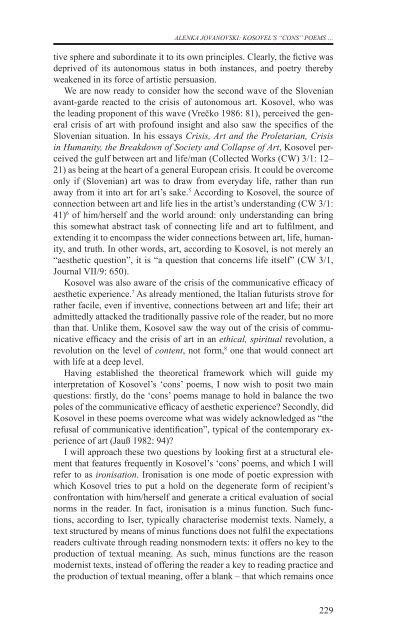razprave (pdf) - Društvo za primerjalno književnost - ZRC SAZU
razprave (pdf) - Društvo za primerjalno književnost - ZRC SAZU
razprave (pdf) - Društvo za primerjalno književnost - ZRC SAZU
- No tags were found...
Create successful ePaper yourself
Turn your PDF publications into a flip-book with our unique Google optimized e-Paper software.
alenka jovanovski: Kosovel’s “Cons” Poems …tive sphere and subordinate it to its own principles. Clearly, the fictive wasdeprived of its autonomous status in both instances, and poetry therebyweakened in its force of artistic persuasion.We are now ready to consider how the second wave of the Slovenianavant-garde reacted to the crisis of autonomous art. Kosovel, who wasthe leading proponent of this wave (Vrečko 1986: 81), perceived the generalcrisis of art with profound insight and also saw the specifics of theSlovenian situation. In his essays Crisis, Art and the Proletarian, Crisisin Humanity, the Breakdown of Society and Collapse of Art, Kosovel perceivedthe gulf between art and life/man (Collected Works (CW) 3/1: 12–21) as being at the heart of a general European crisis. It could be overcomeonly if (Slovenian) art was to draw from everyday life, rather than runaway from it into art for art’s sake. 5 According to Kosovel, the source ofconnection between art and life lies in the artist’s understanding (CW 3/1:41) 6 of him/herself and the world around: only understanding can bringthis somewhat abstract task of connecting life and art to fulfilment, andextending it to encompass the wider connections between art, life, humanity,and truth. In other words, art, according to Kosovel, is not merely an“aesthetic question”, it is “a question that concerns life itself” (CW 3/1,Journal VII/9: 650).Kosovel was also aware of the crisis of the communicative efficacy ofaesthetic experience. 7 As already mentioned, the Italian futurists strove forrather facile, even if inventive, connections between art and life; their artadmittedly attacked the traditionally passive role of the reader, but no morethan that. Unlike them, Kosovel saw the way out of the crisis of communicativeefficacy and the crisis of art in an ethical, spiritual revolution, arevolution on the level of content, not form, 8 one that would connect artwith life at a deep level.Having established the theoretical framework which will guide myinterpretation of Kosovel’s ‘cons’ poems, I now wish to posit two mainquestions: firstly, do the ‘cons’ poems manage to hold in balance the twopoles of the communicative efficacy of aesthetic experience? Secondly, didKosovel in these poems overcome what was widely acknowledged as “therefusal of communicative identification”, typical of the contemporary experienceof art (Jauß 1982: 94)?I will approach these two questions by looking first at a structural elementthat features frequently in Kosovel’s ‘cons’ poems, and which I willrefer to as ironisation. Ironisation is one mode of poetic expression withwhich Kosovel tries to put a hold on the degenerate form of recipient’sconfrontation with him/herself and generate a critical evaluation of socialnorms in the reader. In fact, ironisation is a minus function. Such functions,according to Iser, typically characterise modernist texts. Namely, atext structured by means of minus functions does not fulfil the expectationsreaders cultivate through reading nonsmodern texts: it offers no key to theproduction of textual meaning. As such, minus functions are the reasonmodernist texts, instead of offering the reader a key to reading practice andthe production of textual meaning, offer a blank – that which remains once229
















